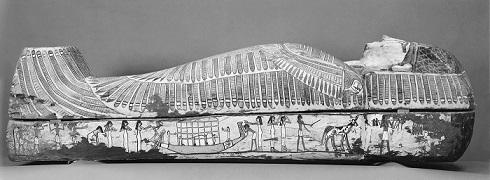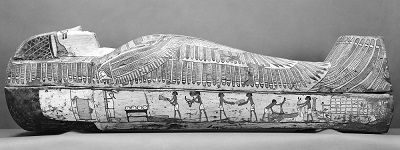
Rishi coffin. Both views with both funerary scenes. XVII-XVIII Dynasty. Thebes. Photo: www.metmuseum.org
Archaeology has brought to light Egyptian coffins dated in the XVII dynasty and in the early XVIII dynasty coming from Thebes and showing an external decoration which should be a help for the corpse regeneration. Due to the limited space which was the surface of the coffin, it seems obvious to think that the ancient Egypt artists working in Thebes had to choose the main or most effective images.
At that point the rishi coffin from the Metropolitan Museum of Art in New York shows at one side the funerary procession with common mourners, one of them making the nwn gesture of shaking hair forwards. On the other side is represented the Opening of the Mouth ceremony, where we can see the coffin flanked by the two women representatives of Isis and Nephtys (Drty). Both elements had to be very important for the mummy who was inside.

Rishi coffin. Left side with the funerary procession. On the left a common mourner shaking hair forwards. XVII-XVIII Dynasty. Thebes. Photo: www.metmuseum.org
The point is: if the Egyptian artist chose these two moments for being present in that decoration it is because they helped in the dead’s resurrection. So, the two mourners in the role of Isis and Nephtys (Drty) were an important part during the Opening of the Mouth ceremony, but this does not mean that the common mourners were less important.

Rishi coffin. Right side with the Opening of the Mouth ceremony.XVII-XVIII Dynasty. Thebes. Photo: www.metmuseum.org
Not only the common mourners were necessary for the funerary ritual of ancient Egypt, but also the nwn gesture of shaking hair forwards was important in that intention of reviving the mummy. Because, as we have seen in former posts, that gesture was not just a sign of desperation and sadness, that shaken hair symbolized the renewing waters, the waters of the primeval moment the dead had to come back to for being reborn. If it would not be like that, the Theban artist of that rishi coffin would not have chosen that common mourner shaking her hair in the decoration.
